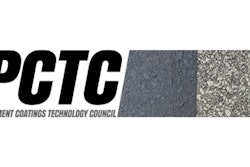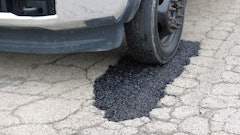FACT: Refined tar-based sealants should be applied with caution.
Appropriate clothing is recommended when applying refined tar sealers, including long sleeves, full-length pants and work gloves. If refined tar sealers contact skin in the presence of sunlight, irritation can occur and applicators may experience “sunburn” effects. Depending on the method of application and weather conditions, a hat and face shield may also be appropriate. Protective creams are available to minimize skin contact with sealer and to block the sun rays that can enhance skin irritation. However, when proper handling and personal hygiene precautions are observed, skin irritation shouldn’t be a problem.
FACT: Refined tar-based sealant is not a significant environmental contaminant.
Activists point to the US Geological Survey (USGS) research to claim that sealants are the main source of polycyclic aromatic hydrocarbons (PAHs) in the environment. However, the USGS has been shown to have manipulated data and used circular reasoning in their sealant studies. Independent studies of New York Harbor and Puget Sound (Seattle) found sealant contributes less than 1% of PAHs to sediments in those locations. A recent independent statistical study of the Illinois River by the Universities of Illinois and Milwaukee-Wisconsin suggested a sealcoat contribution of no more than a few percent. The independent studies are consistent with industry-funded analyses.
FICTION: It’s bad for me that I can smell the sealcoat in the parking lot.
Refined tar-based sealer has a very distinct odor, and the human nose is able to detect it at extremely low concentrations. The smell is primarily the presence of naphthalene, which has an odor threshold about three parts per billion (ppb), a very low concentration. To put this into perspective, the odor threshold for nail polish remover is 7,000 ppb.
The American Conference of Governmental Industrial Hygienists states that the level of naphthalene that is considered safe for workers is ten thousand ppb. Therefore, the difference between being able to smell it and worrying about it is huge.
FICTION: Pavement sealant—specifically refined tar-based sealants—are hazardous.
Air sampling studies showed refined tar-based sealers pose insignificant inhalation risk to applicators, manufacturers or the general public. In fact, millions of people worldwide use coal tar soaps, shampoos and creams approved for use as over-the-counter medicines to treat skin disorders such as eczema and dandruff. Research with insurance carriers shows a general lack of insurance claims over the history of sealant use.
FICTION: Refined tar-based sealants are bad for my health.
Some activists say that refined tar-based sealers are a health threat, but generations of family-owned companies in the business of making or applying sealcoat have zero reports of adverse chronic health effects—including cancer—that can be attributed to exposure to sealcoat.
Coal tar is listed by the US Food and Drug Administration (FDA) as “generally recognized as safe and effective” active ingredients for use to treat these skin ailments with coal tar concentrations up to five percent in over-the-counter products. Many studies have been performed over nearly a century to see if patients who intentionally expose themselves to high level doses of coal tar for long periods of time have increased risk of cancer. All the studies have reached the same conclusion – there is no evidence of cancer.
Be informed. Seal success. To learn more, visit pavementcouncil.org/education


![Lee Boy Facility 2025 17 Use[16]](https://img.forconstructionpros.com/mindful/acbm/workspaces/default/uploads/2025/09/leeboy-facility-2025-17-use16.AbONDzEzbV.jpg?auto=format%2Ccompress&fit=crop&h=100&q=70&w=100)








![Lee Boy Facility 2025 17 Use[16]](https://img.forconstructionpros.com/mindful/acbm/workspaces/default/uploads/2025/09/leeboy-facility-2025-17-use16.AbONDzEzbV.jpg?ar=16%3A9&auto=format%2Ccompress&fit=crop&h=135&q=70&w=240)








